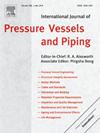HP40Nb reformer tube exposed to 950 °C – Machine learning informed microstructure evolution and multi-scale mechanical properties
IF 3
2区 工程技术
Q2 ENGINEERING, MECHANICAL
International Journal of Pressure Vessels and Piping
Pub Date : 2025-04-09
DOI:10.1016/j.ijpvp.2025.105526
引用次数: 0
Abstract
Austenitic stainless steel tubes extensively employed in energy sector, endure extreme service temperatures over long period of time and are susceptible to creep damage. This study investigates microstructural evolution and mechanical properties of HP40Nb (25Cr35Ni1Nb) steel exposed to 950 °C for up to 1600h, with specimens retrieved at 200h intervals. Advanced multi-scale characterization methods, including scanning electron microscopy, energy dispersive spectroscopy, and micro- and nanoindentation were utilized to analyze transformation of precipitates and resulting impact on mechanical properties. Microstructural changes (precipitate evolution, transformation and coarsening) were quantified using Machine Learning based algorithm and correlated with the mechanical properties. The as-cast microstructure comprised two primary intergranular Cr- and Nb-rich carbides in austenitic matrix. Post 200h exposure at 950 °C, secondary intragranular Cr-rich pepper carbide was observed in the austenite matrix. Following this, segregation of Si around Cr-rich precipitates occurred resulting in dark phases. At 800h, Si migrated to NbC resulting in transformation of NbC to Ni-Nb Silicide phase (G-phase). Transformation of NbC to G-phase and coarsening of the primary Cr-rich carbides was observed towards end of study at 1600h. The microstructural changes resulted in microcracks owing to precipitate transformation, coarsening and thermal coefficient mismatch. It was identified that both Nb and Cr precipitates are susceptible to microcracks post 800h at 950 °C. The study offers improved understanding of microstructural changes occurring in austenitic stainless steels used as reformer tubes during exposure to elevated service temperature.

暴露于950°C的HP40Nb重整管-机器学习通知微观结构演变和多尺度力学性能
能源行业广泛使用的奥氏体不锈钢管长期承受极端的工作温度,容易发生蠕变损伤。本研究调查了 HP40Nb(25Cr35Ni1Nb)钢在 950 °C 下暴露长达 1600 小时的微观结构演变和机械性能,每隔 200 小时取回试样。利用先进的多尺度表征方法,包括扫描电子显微镜、能量色散光谱以及微米级和纳米级压痕,分析了析出物的转变及其对机械性能的影响。使用基于机器学习的算法量化了微结构变化(沉淀演变、转变和粗化),并将其与机械性能相关联。铸造时的微观结构包括奥氏体基体中两种主要的晶间富铬和富铌碳化物。在 950 °C 下暴露 200 小时后,在奥氏体基体中观察到二次晶内富含铬的辣椒碳化物。随后,硅在富铬沉淀物周围发生偏析,形成暗相。800 小时后,硅向铌碳迁移,导致铌碳转变为镍铌硅化物相(G 相)。在研究即将结束时(1600 小时),观察到 NbC 向 G 相的转变和原生富铬碳化物的粗化。由于沉淀转化、粗化和热系数不匹配,微结构变化导致了微裂纹。研究发现,铌和铬析出物在 950 ℃ 下经过 800 小时后容易产生微裂纹。这项研究加深了人们对用作转化炉管的奥氏体不锈钢在暴露于较高使用温度时发生的微观结构变化的理解。
本文章由计算机程序翻译,如有差异,请以英文原文为准。
求助全文
约1分钟内获得全文
求助全文
来源期刊
CiteScore
5.30
自引率
13.30%
发文量
208
审稿时长
17 months
期刊介绍:
Pressure vessel engineering technology is of importance in many branches of industry. This journal publishes the latest research results and related information on all its associated aspects, with particular emphasis on the structural integrity assessment, maintenance and life extension of pressurised process engineering plants.
The anticipated coverage of the International Journal of Pressure Vessels and Piping ranges from simple mass-produced pressure vessels to large custom-built vessels and tanks. Pressure vessels technology is a developing field, and contributions on the following topics will therefore be welcome:
• Pressure vessel engineering
• Structural integrity assessment
• Design methods
• Codes and standards
• Fabrication and welding
• Materials properties requirements
• Inspection and quality management
• Maintenance and life extension
• Ageing and environmental effects
• Life management
Of particular importance are papers covering aspects of significant practical application which could lead to major improvements in economy, reliability and useful life. While most accepted papers represent the results of original applied research, critical reviews of topical interest by world-leading experts will also appear from time to time.
International Journal of Pressure Vessels and Piping is indispensable reading for engineering professionals involved in the energy, petrochemicals, process plant, transport, aerospace and related industries; for manufacturers of pressure vessels and ancillary equipment; and for academics pursuing research in these areas.

 求助内容:
求助内容: 应助结果提醒方式:
应助结果提醒方式:


